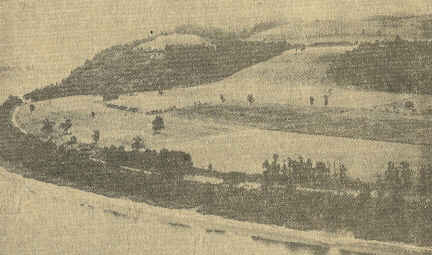|
The first county school probably was started in 1811-1812 in a log house near Smiths Mill, taught by W. H. Grafton. Charles Stewart taught in a cabin near Nessly's Mill in 1826 and Mark McGarven taught in 1811 in a cabin near the Allison residence.
In 1864, with the formation of new state of West Virginia which separated from Virginia over the Civil War issues, elections were held with Jonathan Allison as supervisor for Grant District, James Hewitt as justice of the peace and Charles Allison as constable.
With the establishment of a free school system in West Virginia in 1863, five schools were created in Grant District -- Hamiltontown School (now Congo), the "Pottery School" at the present site of Newell, Washington, Brooklyn and Franklin School.
The "Pottery School" -- so termed because of its proximity to a pottery at the north end of the town site during the Civil War period - was used until 1890 when it was abandoned, and area pupils went to classes at Chester.
The site of Newell continued as a farm district and was noted chiefly as a ferry terminus operated by the Todd family to Jethro Hollow, and later operated by the Newell family.
After the middle of the century a yellow ware [1] plant was built near the end of the present Newell Bridge by Curits and James Larkins and William Thompson. It was forced to suspend operations, however.
Some older residents recall a pottery being built by some Trenton, N.J. men which was later torn down between 1864 and 1880 and the bricks carried by skiffs across the river for construction of another pottery.
Youngsters of the town later walked in the ruins of the old pottery and picked up the handmade setter pins used in the ware production.
 About 1891 a Pittsburgh syndicate headed by William F. Lloyd took options on the farms of John Newell, J. Bentley Newell, William McDonald and land of a Wells family, known as the Murry tract, and a Moore tract. The syndicate planned the development of the area for and industrial site.
In 1898 the syndicate contacted farms adjoining the lands it held in an effort to have them give a portion of their property to lay out the general area into a town site along with a planned location of a "big rolling mill or factory of some kind" which would give employment to a large number of people. This did not work out.
However, the future of the tract was being studied with more determination and business know how by a group of men across the river in East Liverpool, headed by the leaders in the Homer Laughlin China Company. About 1891 a Pittsburgh syndicate headed by William F. Lloyd took options on the farms of John Newell, J. Bentley Newell, William McDonald and land of a Wells family, known as the Murry tract, and a Moore tract. The syndicate planned the development of the area for and industrial site.
In 1898 the syndicate contacted farms adjoining the lands it held in an effort to have them give a portion of their property to lay out the general area into a town site along with a planned location of a "big rolling mill or factory of some kind" which would give employment to a large number of people. This did not work out.
However, the future of the tract was being studied with more determination and business know how by a group of men across the river in East Liverpool, headed by the leaders in the Homer Laughlin China Company.
These pottery men were alert to the expanding market for mass produced dinnerware, and had been enlarging the Laughlin firm in East Liverpool since it was sold by the elder Laughlin in 1896 to the Marcus and Louis Aaron group of Pittsburgh.
Two new plants were constructed at Laughlin Station in the East End, each with 15 kilns, and the firm exchanged the old six-kiln plant in the East End near the other two factories. These plants were in operation by 1902, but already were becoming inadequate.
The growing mechanization of the industrial world, the spreading market and the national trend toward corporation expansion were factors which brought the new action by the company.
1 Yellow ware is heavy bodied utilitarian ware (mixing bowls, crocks, storage vessels) and so named because of the yellow coloring in the clay.
|